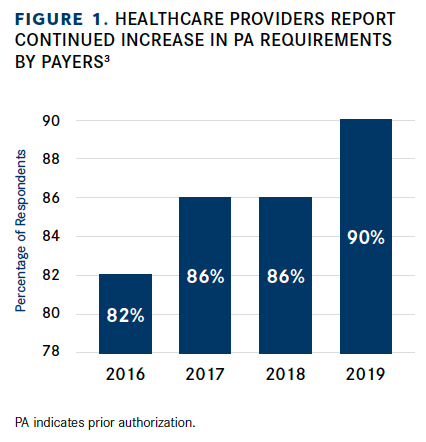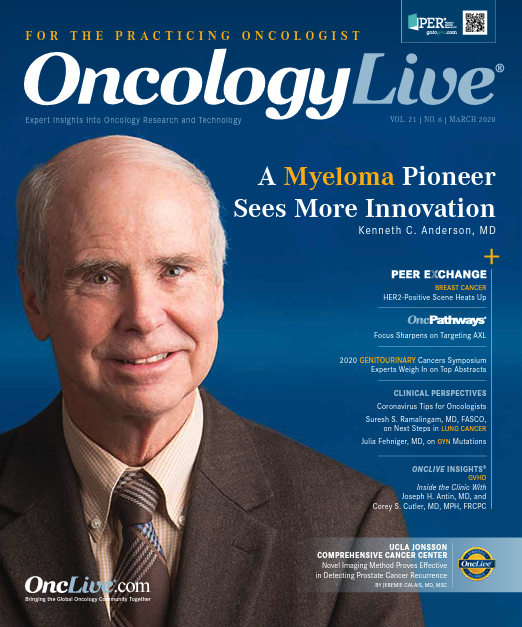Publication
Article
Automated Prior Authorization Catches On
Author(s):
In January, America’s Health Insurance Plans in collaboration with payers representing 60 million covered individuals launched the Fast Prior Authorization Technology Highway to improve the prior authorization process.
Karina Abdallah, PharmD

Karina Abdallah, PharmD
The manual labor involved in obtaining prior authorizations (PAs) is a well-recognized burden among providers. Up to 46% of PA requests are still submitted by fax, and 60% require a telephone call, according to America’s Health Insurance Plans (AHIP).1 A 2018 survey by the American Medical Association (AMA) found that doctors and their staff spend an average of 2 days a week completing PAs.2 In addition to eating up time that physicians could spend with patients, PAs also contribute to burnout.
Further, the requirements for PAs appear to be increasing. A survey by the Medical Group Management Association (MGMA), which advocates on behalf of physicians, indicated that 90% of physician respondents (N = 999) said PA requirements by payers increased in 2019. Just 1% indicated they decreased. PA requirements have steadily increased since 2016, according to respondents (FIGURE 1).3
Click to Enlarge

In January, AHIP in collaboration with payers representing 60 million covered individuals launched the Fast Prior Authorization Technology Highway (Fast PATH) to improve the PA process. The system lets providers access a patient’s benefit entitlements and, if required, submit PA requests directly through the EHR. Payers in this initiative include Anthem, Blue Shield of California, Cambia’s affiliated health plans, Cigna, Florida Blue, and WellCare.1
Various software vendors are stepping into this space. Recondo said in a 2019 release that its AuthInitiate system could reduce average time spent on PA requests “from a manual 25 minutes to less than 3 minutes.”5
Although payers are often the target of contentions that they deliberately stymie the PA process to keep claims costs as low as possible, they have much to gain from participating in automated PA, according to Karina Abdallah, PharmD, clinical operations manager at Blue Cross Blue Shield of Michigan. For payers, electronic PAs reduce manual labor and enable sophisticated, real-time tracking and measurement of requests that allow not only payers but also drug manufacturers to enact rapid interventions, should inefficient or undesired trends emerge.
Abdallah, who discussed the issue at the recent Specialty Therapies and Biosimilars Congress, in Miami, Florida, said Blue Cross Blue Shield uses incentives and continuous coaching to encourage staff to promote the use of electronic PAs by providers. “High utilization of existing tools ensures that payers feel justified expanding capabilities to further automate the processes, thereby reducing provider burden,” she explained.
Individual practices are finding that among these new systems, opportunities exist to significantly cut down on the routine tasks inherent in PA and free up staff and financial resources for other activities. This is sometimes referred to as robotic process automation (RPA).
“RPA is helpful if the process is routine and repetitive,” said Alti Rahman, MHA, MBA, CSSBB, practice administrator at Oncology Consultants in Houston, Texas. “The idea is that RPA essentially takes those routine steps and performs [them] for you.”
RPA, a set of technologies and processes designed to automate otherwise manual work, has been shown to help solve the manual and disparate nature of the PA process, according to Syam Palakurthy, CEO of SamaCare, a vendor and designer of software for addressing administrative needs of practices. SamaCare, based in the San Francisco Bay Area, California, has built a system for managing and tracking PAs for specialty medications that several practices currently use.
RPA may involve automatically pulling relevant information from EHRs or tracking responses for authorization requests from payers. It enables a practice to use a single interface for all relevant payers, relying on automation to translate the practice’s input into the payer’s unique tax forms and eliminating the need to learn individual payers’ systems.
COMPLEXITY SPURS INNOVATION
The origin of electronic PA is rooted in the increasingly omplex nature of modern practice, especially in oncology. An increased knowledge base and the development of novel therapies have contributed to improved outcomes for patients with both early- and late-stage cancer. These advances have occurred in parallel with increased costs of providing optimal oncology care.6 Many medical payers have imposed requirements for PA related to aspects of cancer care, including imaging, molecular testing, surgery, oral, infusional antineoplastic agents, and supportive care therapies. However, PAs have not only contributed to administrative burden for providers and payers but have also delayed care or caused suboptimal therapy for patients. As a result, software vendors and many on the provider and payer sides increasingly pitch RPA as a way to improve practice workflows and PA processes.
The PA process was designed to ensure that a requested therapy fits within care guidelines and the medical rationale for use provided by the clinician to the medical payer. “PA would provide certainty to providers of reimbursement, confidence to payers of medical and financial appropriateness, and assurance to patients of getting the best therapy for their circumstances,” explained Palakurthy.
“Specialty drugs, a class of drugs that are more personalized, complex to manufacture, and expensive, are especially likely to require PA,” Palakurthy said. “As the number of specialty drugs has grown by approximately 1200% since the mid-1990s, payers have ratcheted up the requirements to use them.”
For these specialty drugs, providers follow a unique process for each drug and payer. “Sometimes they fax paper documents, sometimes they enter information through idiosyncratic payer web portals, and sometimes they submit PAs via time-consuming phone calls,” Palakurthy noted.
Following the implementation of PA requirements, payer pressures, including PA and coverage denials and appeals, were reported as the top practice pressures in a 2017 American Society of Clinical Oncology survey of 7203 hematologists and oncologists. 7 Further, in the PA survey of 1000 practicing physicians conducted by the AMA, 86% of respondents reported a high or extremely high burden associated with PA in their practice. Notably, 88% of respondents reported that PA burdens have increased over the past 5 years, with practices seeing an average of 31 PA requests per physician each week (FIGURE 2).2
“The basis for what [payers] use to determine what the rules are for approval can vary payer by payer because each payer could have their own set of guidelines,” Rahman said. He believes the need to cover multiple specialties in medicine has prevented payers from devising a simplified, uniform set of oncology practice guidelines.
Other challenges for the PA process include the use of antiquated technology, such as fax, which is labor intensive. Also, payers have varying degrees of sophistication for informing practices when they have completed a PA. Practices may have to check to determine whether a PA has been read. “That disconnect leads to frustration,” Rahman said.
Click to Enlarge

According to Palakurthy, providers must gather data for payers, submit the PA, and review the payer’s response to the PA request. This process becomes more complex based on the unique mechanism for each payer, which may include particular tax forms, web portals, or phone-based requests. Furthermore, a payer may change the PA process at any time. “The disparate process requires the practice to learn several dozen processes and forms for each payer, rather than becoming proficient on 1 consistent process,” Palakurthy said. “As a consequence of the manual and disparate process, delays and errors creep in that ultimately harm patient care.”
According to the AMA survey, 91% of physicians reported care delays associated with treatments requiring PA, with 28% reporting that the PA process contributed to serious adverse events, including death, hospitalization, disability or permanent bodily damage, and other life-threatening events.2 Additionally, 75% reported that issues related to the PA process led to patients abandoning the recommended treatment course, and 91% perceived an overall significant or somewhat negative impact of the PA process on patient clinical outcomes.
AUTOMATION CLEARS THE WAY
RPAs can help address the redundancies of the PA process and streamline a provider’s associated tasks. “RPA can facilitate that and essentially use technology to see [whether] a status has changed or not and retrieve that information for you as well,” said Rahman, who uses the SamaCare system for RPA.
“RPA can also help payers streamline internal operations,” explained Palakurthy. By allowing providers to easily send information digitally rather than through fax or phone, payers are more likely to receive PA requests in a structured form. Palakurthy also noted that the combined use of structured data and systematized protocol will enable payers to automate their PA processes.
“The SamaCare system digitizes the prior authorization process and uses RPA to streamline the time and effort required to get PA approval,” Palakurthy said. “Several practices have described SamaCare as speeding up their PA workflow by 2 to 4 times and reducing the likelihood of errors that could cause patient delays or financial losses for the practice.”
Rahman’s practice has created an automated process for 5 payers. The system automatically pulls from the EHR and facilitates the data transfer into each of the payers’ portals. “The need for visiting those portals has really completely diminished,” Rahman explained. “Of course, we have received nothing but positive feedback on being able to flatten that experience.”
Rahman cautioned that practices should ensure they understand the process before hiring a vendor to create RPA processes. Practices can evaluate many technologies on a trial basis to better understand their nature before purchasing. “When we started the process, we had some understanding of what RPA was and we started creating our own processes, so we had some idea of what we were going into,” Rahman said.
LOOKING FORWARD
“The next few years will move us closer to an ideal where payer-practice communication facilitates patient care rather than harming it,” explained Palakurthy. He anticipates that, with time, an increasing amount of this work will be automated. “This will help push administrative burdens to having the right amount of influence on patient care: none.”
Ideally, Rahman concluded, just 1 set of rules would exist for PA, across all payers, but he doubts that will happen. “Ideally, it would be nice if all payers could operate through a singular PA clearinghouse where the rules were the same.”
To obtain PA, physicians may need to speak with payer representatives on a peer-to-peer basis to justify ordering a particular test or treatment for a patient. The peer may be a pharmacist or a physician from a different specialty who lacks expertise in oncology, which may increase the difficulty in that justification of a requested therapy.
MGMA findings also indicated that PA processes at provider practices remain largely manual: 52% are fully manual, 36% are partially electronic, and 12% are fully electronic. 4 However, software is now available to help synchronize electronic health records (EHRs) with payer portals and automate the PA process.

Latest Conference Coverage
2 Commerce Drive
Cranbury, NJ 08512








